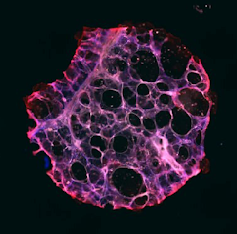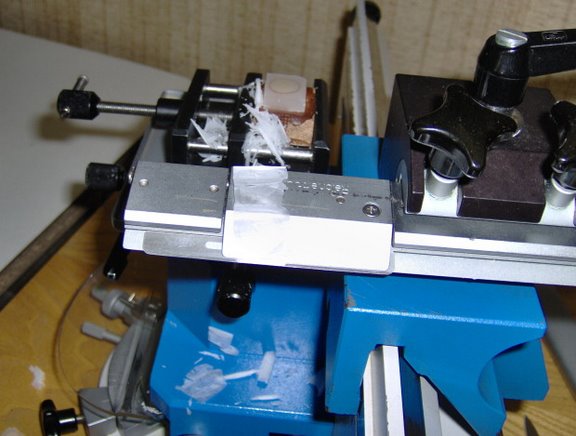|
Precision Cut Lung Slices
Precision cut lung slices or PCLS refer to thin sections of lung tissue that are prepared with high precision and are typically used for experimental purposes in the field of respiratory research. These slices are utilized to study various aspects of lung physiology, pathology, and pharmacology, providing researchers with a valuable tool for investigating lung diseases and testing the effects of drugs on lung tissue. Precision cut lung slices are prepared using specialized equipment called Vibratomes, ensuring that the tissue remains viable and retains its structural and functional characteristics, making them ideal for a wide range of experimental applications. History The history of Precision-cut Lung Slices (PCLS) dates back to the 1920s when scientists first explored tissue slices for studying organ metabolism and toxicology. Initially, manual slicing of tissues, such as the liver, led to significant variability in thickness and limited viability. A critical advancement occu ... [...More Info...] [...Related Items...] OR: [Wikipedia] [Google] [Baidu] |
Vibratome
A microtome (from the Greek ''mikros'', meaning "small", and ''temnein'', meaning "to cut") is a cutting tool used to produce extremely thin slices of material known as ''sections'', with the process being termed microsectioning. Important in science, microtomes are used in microscopy for the preparation of samples for observation under transmitted light or electron radiation. Microtomes use steel, glass or diamond blades depending upon the specimen being sliced and the desired thickness of the sections being cut. Steel blades are used to prepare histological sections of animal or plant tissues for light microscopy. Glass knives are used to slice sections for light microscopy and to slice very thin sections for electron microscopy. Industrial grade diamond knives are used to slice hard materials such as bone, teeth and tough plant matter for both light microscopy and for electron microscopy. Gem-quality diamond knives are also used for slicing thin sections for electron microsc ... [...More Info...] [...Related Items...] OR: [Wikipedia] [Google] [Baidu] |
Microtome
A microtome (from the Greek ''mikros'', meaning "small", and ''temnein'', meaning "to cut") is a cutting tool used to produce extremely thin slices of material known as ''sections'', with the process being termed microsectioning. Important in science, microtomes are used in microscopy for the microscope slide, preparation of samples for observation under transmitted visible light, light or electron radiation. Microtomes use steel, glass or diamond blades depending upon the specimen being sliced and the desired thickness of the sections being cut. Steel blades are used to prepare histological sections of animal or plant tissues for light microscopy. Glass knives are used to slice sections for light microscopy and to slice very thin sections for electron microscopy. Industrial grade diamond knives are used to slice hard materials such as bone, teeth and tough plant matter for both light microscopy and for electron microscopy. Gem-quality diamond knife, diamond knives are also used ... [...More Info...] [...Related Items...] OR: [Wikipedia] [Google] [Baidu] |
Vibratome
A microtome (from the Greek ''mikros'', meaning "small", and ''temnein'', meaning "to cut") is a cutting tool used to produce extremely thin slices of material known as ''sections'', with the process being termed microsectioning. Important in science, microtomes are used in microscopy for the preparation of samples for observation under transmitted light or electron radiation. Microtomes use steel, glass or diamond blades depending upon the specimen being sliced and the desired thickness of the sections being cut. Steel blades are used to prepare histological sections of animal or plant tissues for light microscopy. Glass knives are used to slice sections for light microscopy and to slice very thin sections for electron microscopy. Industrial grade diamond knives are used to slice hard materials such as bone, teeth and tough plant matter for both light microscopy and for electron microscopy. Gem-quality diamond knives are also used for slicing thin sections for electron microsc ... [...More Info...] [...Related Items...] OR: [Wikipedia] [Google] [Baidu] |
Physiological Relevance
Physiological relevance is a scientific concept that refers to the applicability or significance of a particular experimental finding or biological observation in the context of normal bodily functions. This concept is often used in biomedical research, where scientists strive to design experiments that not only yield statistically significant results but also have direct implications for understanding human health and disease. Importance in biomedical research Physiological relevance is a critical factor in biomedical research because it helps to bridge the gap between basic science and clinical application. Researchers aim to design studies that not only yield statistically significant results but also have direct implications for understanding human health and disease. For example, a study on the effects of a new drug on cancer cells in a lab dish might show promising results. However, these findings would only be considered physiologically relevant if the drug also demonstrat ... [...More Info...] [...Related Items...] OR: [Wikipedia] [Google] [Baidu] |
Histology
Histology, also known as microscopic anatomy or microanatomy, is the branch of biology that studies the microscopic anatomy of biological tissue (biology), tissues. Histology is the microscopic counterpart to gross anatomy, which looks at larger structures visible without a microscope. Although one may divide microscopic anatomy into ''organology'', the study of organs, ''histology'', the study of tissues, and ''cytology'', the study of cell (biology), cells, modern usage places all of these topics under the field of histology. In medicine, histopathology is the branch of histology that includes the microscopic identification and study of diseased tissue. In the field of paleontology, the term paleohistology refers to the histology of fossil organisms. Biological tissues Animal tissue classification There are four basic types of animal tissues: muscle tissue, nervous tissue, connective tissue, and epithelial tissue. All animal tissues are considered to be subtypes of these ... [...More Info...] [...Related Items...] OR: [Wikipedia] [Google] [Baidu] |




